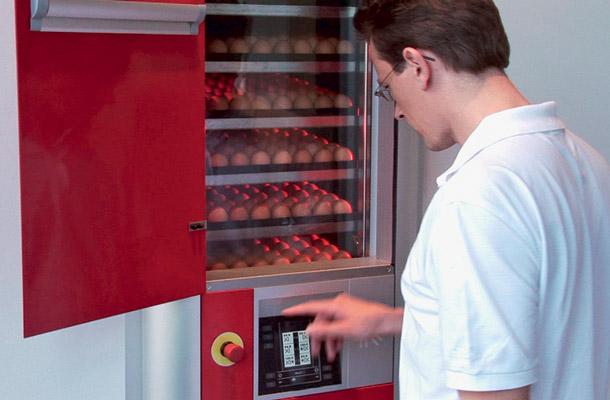Pre-heating - an effective tool for chick uniformity
Tags: Incubation | Whitepaper
, August 27 2010

Modern poultry management for meat production aims to deliver uniform birds to the slaughterhouse. Hatchery practice plays an important role, because success at farm level is greatly enhanced by the receipt of chicks with uniform growth potential.
The hatchery manager using modular single-stage incubators with a pre-heating function has a distinct advantage, because he or she has the necessary tools to effect a uniform start for every embryo in the incubation cycle.
Preheating brings the eggs to a uniform temperature of 25 ˚C (77 ˚F) in an operating setter, prior to the onset of incubation. This is the first step towards achieving a short hatch window - and therefore a uniform hatch. In the absence of a pre-heat function on the incubator, eggs can be pre-warmed by placing filled setter trolleys in the setter room.
The hatchery’s key aim should be to provide an even, uniform start for all embryos placed in incubation. Preheating makes such a difference, because it minimises variations in embryo temperature at the moment when air temperature inside the incubator reaches 38.0 ˚C (100.4 ˚F) set point. Variations in egg temperature will be further reduced when eggs are sorted by weight and when incubators with higher heating capacity are used to ensure a uniform start of embryonic development for all the eggs placed inside.
Eggs from different batches are often set in the same incubator, either because the eggs have originated from different farms, or because eggs from different production days have been stored until there are sufficient to completely fill the setter.
Between batches, egg temperatures can differ - especially when, for example, setting is planned for the date of delivery for some, mixed with others taken and set directly from the hatchery cold store.
Variation in egg temperature will also occur as a result of taking eggs from the storage room at different times for loading into the setter. The table below, illustrates that without the benefit of preheating, variation in eggshell temperature is greater after several hours of heating at incubation set point, especially when using an incubator with a lower heating capacity.
Preheating starts off low level cellular processes in some of the embryonic cells. These processes should not be interrupted or halted in any way once they have begun and preheating must be followed immediately by incubation at a setpoint of 38.0 ˚C (100.4 ˚F) to achieve optimum embryonic temperature of 37.8 ˚C (100 ˚F).
Advice
Preheating eggs prior to incubation is an advantage when seeking optimum chick uniformity. For this reason, modular, single-stage incubation and high heating capacity are also recommended.
For incubators with a pre-heating programme
Use the pre-heating programme for the most uniform start to embryonic development. Starting the incubation cycle after internal egg temperature has reached 25 ˚C/77 ˚F (5 - 6 hours after preheat begins) reduces the risk of early mortality.
For incubators without a pre-heating programme
Pre-warm eggs to 25 ˚C in the setter room for a minimum of 12 hours. Trolleys loaded with eggs should be separated to ensure warm air circulates properly to all eggs.
Range in egg temperatures after heating with or without preheating in incubators with two different heating capacities. Egg weight varies between 50 - 70 grams.
| Range of egg temperatures before setting | 10 hours heating with 2500 W heating capacity | 7 hours heating with 4000 W heating capacity |
| 14 - 20 ˚C |
No preheating Including 5 hours preheating 33.2 - 37.8 ˚C 34.6 - 37.8 ˚C |
No preheating Including 3 hours preheating 35.5 - 37.8 ˚C 37.3 - 37.8 ˚C |
| 57.2 - 68 ˚F | 91.8 - 100 ˚F 94.3 - 100 ˚F | 95.9 - 100 ˚F 99.1 - 100 ˚F |